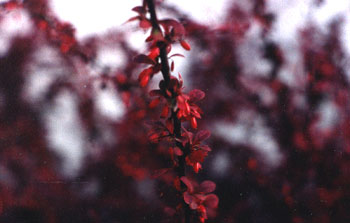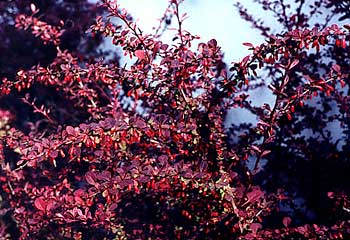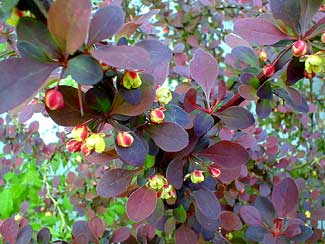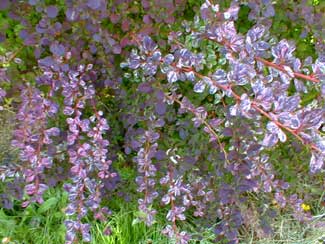 'Rose Glow' Japanese Red Barberry
'Rose Glow' Japanese Red Barberry
"In barberry bells the gray moths sup."
-William Vaughn Moody
(1869-1910)
(1869-1910)
I admit it, I don't like to get stabbed, & chances are I would never have bought a barberry bush had I been asked. But there were already four six-foot tall Red Barberries (Berberis thunbergii var atropurpurea 'Rose Glow') planted up near the house when we bought this place, plus two of a small golden-leafed variety.
There are many kinds of barberries, but 'Rose Glow' Red Barberry & the Golden Barberry ( B. t. 'Aurea') are the two most commonly seen around here. The red is sometimes labeled 'Rosy Glow' or just 'Atropurpurea.' The red & the gold are frequently real eye-catchers, especially the Red which is not just red-leafed but red & purple & crimson & pink-leafed with streaks & stripes, & the red twigs are almost as colorful.
The coloration of the leaves changes throughout the year, so that sometimes the individual leaves are solid colors in every purplish shade, & sometimes the leaves are truly variegated purple & red with white stripes. The fourth photo snapped in August (2003) shows one of these shrubs at the height of its variegated stage. For additional portraits in Autumn, see Red Barberry page, in the Autumn Leaves Gallery.
 About mid to late April, or early May, it gets yellow flowers. The third photograph down this page was taken at the start of the third week of April, & shows the red leaves & yellow blossoms in close-up (larger than life size). Unfortunately the musty perfume of these flowers is reminiscent of a wet male goat. Fortunately it stops stinking as soon as it gets good & pollinated.
About mid to late April, or early May, it gets yellow flowers. The third photograph down this page was taken at the start of the third week of April, & shows the red leaves & yellow blossoms in close-up (larger than life size). Unfortunately the musty perfume of these flowers is reminiscent of a wet male goat. Fortunately it stops stinking as soon as it gets good & pollinated.Note also that this April bloom photo shows solid purple leaves, although this is from the same shrub which in the fourth photo later in the year developed variegated leaves (which will return to a bright red before autumn leaf-fall).
Spring's yellow flowers are soon tiny tear-drop-shaped bright red berries, that can last nearly year-round. The first photo up top shows the berries. This is its appearance early in Autumn — red berries amidst stickery purple foliage. For an additional view of the berries, see the Barberry Page of the Berries Gallery.
The second photo was taken the same Autumn (2001). By December the barberry will have dropped all its leaves but still fully decorated with the tiny red berries, which last through most of the winter on the majority of bushes, & until the following spring on sheltered shrubs, so the Red Barberry possesses considerable winter interest.
 So it turns out I do like these shrubs for their beauty & ease of care, so am not too sorry someone else made the decision to put them in. But I must admit, I've seen some other varieties by chance at garden shops & started to say, "Oh, that's beautiful, what is . . . ouch! it's one of them gawdam barberries!"
So it turns out I do like these shrubs for their beauty & ease of care, so am not too sorry someone else made the decision to put them in. But I must admit, I've seen some other varieties by chance at garden shops & started to say, "Oh, that's beautiful, what is . . . ouch! it's one of them gawdam barberries!" One of the Reds the previous owner planted in front of a window. I wanted light to get in that window so I had to move the bush, which anyway had been planted too close to other things. It was so deeply rooted it took some damage getting it up, but it sprang back to life the following year no worse for wear. But while I was moving it, it must've been pretty pissed off about losing it's place before the window, as it kept stabbing me. I was cussing up a storm. I also learned after the first year not to compost any pruned bits. It'll still poke a hole in you when the rest of the compost is ready to recycle back into gardens.
Another of the Reds was planted right beside the side-door to the house. That one was even more in the way, plus when in flower stank up the entrance. *t was a year before I moved that one too, & put it near the other on the roadside.
 The ground by the road is not nearly so nice, but the Red barberries don't seem to mind, just so long as they get water while re-establishing. It is somewhat drought-tolerant when the roots are well set, & the roadside garden is by & large a low-maintenance affair. The barberries don't seem to mind neglect but do require occasional deep watering in the harshest summer days.
The ground by the road is not nearly so nice, but the Red barberries don't seem to mind, just so long as they get water while re-establishing. It is somewhat drought-tolerant when the roots are well set, & the roadside garden is by & large a low-maintenance affair. The barberries don't seem to mind neglect but do require occasional deep watering in the harshest summer days.Two of the four barberries were still right up alongside the house, until, for a third year running, I moved yet another, transplanting it off the property near a telephone phone pole by the road, with an ultra-hardy ground-cover evergreen Sun Rose near its foot. This spot stretched its adaptability too much & though the sun-rose naturally enough did great, the barberry went on to the big garden in the sky.
As of 2004 there was only one barberry remaining right by the house. If not kept trimmed back it got in the way of the patio. But Granny Artemis insisted it's beauty more than made up for a week or two of musty odor & year-round thorns; & it was sufficient that we had gotten three out of four of the big red barberries out of there.
So this last one remained until 2009. By then it was so fantastically large (more than six feet tall & almost as wide, despite periodic harsh pruning) & so thick-rooted that the attempt to dig it out was a nightmare. So it got cut down to the crown.
I can scarsely believe we let it molest us in that location for the bulk of the decade. The patio is much more comfortable, & the shrub's former location is now taken up with a huge wrought iron breadrack of potted plants, plus a wooden table with carniverous plants displayed. It's so nice to be rid of that mean ol' barberry, & as for its beauty, the two out on the road continue to do great.